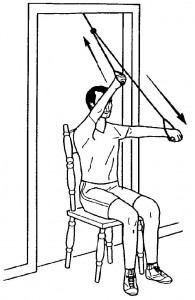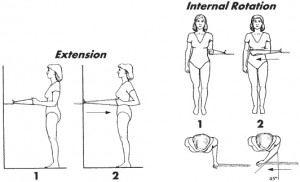Warning: Parameter 2 to wp_hide_post_Public::query_posts_join() expected to be a reference, value given in /home/fearlessmen/public_html/wp-includes/class-wp-hook.php on line 310
 Shoulder injuries are way more common than you’d expect. 6 months ago I had minor shoulder surgery for bursitis and bone spurs. The San Diego Chargers team doctor knew a thing or two so I consulted him. He had tried a cortisone shot and 10 sessions of physical therapy with no improvements. He recommended surgery and I took his advice. After a successful surgery I went through 2 months of physical therapy. From there I graduated to taking my exercises home and have continued with it the last 4 months.
Shoulder injuries are way more common than you’d expect. 6 months ago I had minor shoulder surgery for bursitis and bone spurs. The San Diego Chargers team doctor knew a thing or two so I consulted him. He had tried a cortisone shot and 10 sessions of physical therapy with no improvements. He recommended surgery and I took his advice. After a successful surgery I went through 2 months of physical therapy. From there I graduated to taking my exercises home and have continued with it the last 4 months.
You might be wondering what happened that my shoulder was awarded 6 months of special care and attention. Well, you could say it was the 4 months of pain it caused me. Or maybe the 5 previous years of it not being treated properly because of a misdiagnosis in the Army, where the injury originally occurred.
What is Bursitis?
Since I’m no doctor let’s hear it straight from the WebMD:
Bursitis is the inflammation or irritation of the bursa. The bursa is a sac filled with lubricating fluid, located between tissues such as bone, muscle, tendons, and skin, that decreases rubbing, friction, and irritation.
What Causes Bursitis?
Bursitis is most often caused by repetitive, minor impact on the area, or from a sudden, more serious injury. Age also plays a role. As tendons age they are able to tolerate stress less, are less elastic, and are easier to tear.
Overuse or injury to the joint at work or play can also increase a person’s risk of bursitis. Examples of high-risk activities include gardening, raking, carpentry, shoveling, painting, scrubbing, tennis, golf, skiing, throwing, and pitching. Incorrect posture at work or home and poor stretching or conditioning before exercise can also lead to bursitis.
http://www.webmd.com/pain-management/arthritis-bursitis
In layman terms this means a lot of pain and you won’t even be able to push open your car door.
This is how I initially injured it 5 years ago and what I learned from the Army:
You remember how I mentioned the injury happened in the Army? It was a sudden injury that occurred between me and a M2 Machine Gun that I was carrying like John Rambo.
The Army said it was tendonitis and a little physical therapy was all I needed. Even though it did improve, the sharp pain never went completely away. I never had it looked at again because I wanted to be “tough”. In the end it’s my responsibility and the blame is mine. But there are lessons to be learned.
Lesson 1 – Don’t carry a M2 Machine Gun by yourself. It’s called a crew-served weapon for a reason – Two People. Just because your first name is John does not mean you are John Rambo.
Lesson 2 – Doctors are not always right. Get a 2nd opinion if you’re even slightly concerned.
Lesson 3 – When the Army says, ‘Drink water and drive on’. “Water” is not a medicine, even if it does help keep your mouth shut.
Lesson 4 – When the medic gives you “pain killers” that’s exactly what they are – pain killers. Not medicine and they do not heal you.
Lesson 5 – Listen to your body
But what you’re here for and what actually brought you to my article is how to recover from a shoulder injury, so let’s fast forward to 2013 and go over the hour I spent with Physical Therapy for 20 sessions over 2 months.
First 5 minutes – Arm Exercise Bike to help loosen up the shoulder
Next 10 to 15 minutes – Awesome shoulder massage and stretching. This was my favorite part by far and made the $20 copay worth it.
But if they were all busy I had to start with a pulley to stretch my arm. If it looks fun to you I can tell you it’s not. Maybe I lack coordination but my thumb kept getting pinched by the ropes and handle.

Next 30 minutes – This is where discipline came in.
1) Drawing Circles – No you won’t get dizzy but you do start drawing stuff and have to focus to only draw circles.
2) The Pendulum – That little 5lb weight gets very heavy…quick.

3) Resistance Bands – Fun part was people watching and getting distracted, then having them yell at me to correct my posture.


4) This one is easier then it looks and is a good way to tell how the post surgery healing is progressing. Because of the angle and pressure that’s applied to the shoulder it’ll hurt a ton if the weights too heavy.
5) Wall Push-up – A year before the surgery I could do 90-100 normal pushups. After re-injuring my shoulder I couldn’t do one. Post-surgery I struggled using the wall. Now (6 months after surgery) I can do around 50 normal ones and I got an exercise ball to include into my routine. 
Final 10 minutes – Icing my shoulder down
There were a few more exercises than this that I couldn’t find pictures of. The ones you see here I started out with light weights or resistance and gradually added more. I’m surprised how fast my shoulder healed. 2 months after surgery I was back out playing basketball, and I sure do stretch a lot more then I used to.
If you’ve injured your shoulder and are pushing off having it checked out I strongly encourage you to not wait.
5 years after the initial injury is when I re-aggravated it and it was far worse then the first time. Had I had it properly treated 5 years ago I wouldn’t of been in this predicament and saved $1500. Plus, from your 1st appointment until surgery it can be months. You have to go through a physical exam and get MRI’s and x-rays. Sometimes it can be a full week or more between each one. The results have to be produced and then the doctor reviews them. For a coworker of mine it took 8 months between the 1st appointment and surgery. I was fortunate to only endure it for 4 months.
